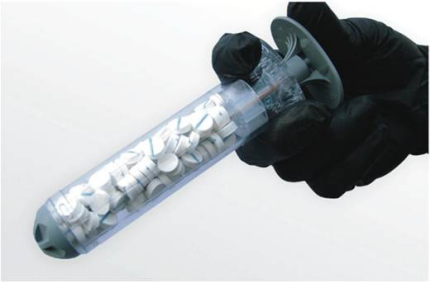Army's injectable bandage can stop heavy bleeding during 'the golden hour'
The XSTAT, developed by the Combat Casualty Care Research Program and RevMedx, just received FDA approval.

It’s a surprisingly straightforward invention that could go a long way toward saving lives on the battlefield—a syringe-like device that essentially injects bandages into deep wounds to prevent bleeding.
Developed by the Combat Casualty Care Research Program of the U.S. Army Medical Research and Materiel Command at Fort Detrick, Md., the XSTAT looks like a large syringe and contains small cellulose sponges that, once injected, expand to fill a wound. Designed for use against large, deep injuries, it’s intended to be used on wounds around joints such as the shoulder or groin, where medics couldn’t apply a tourniquet, or wounds that are too deep for a dressing, according to Army researchers.
XSTAT last week received Food and Drug Administration approval and will be available commercially, via manufacturer RevMedx, which worked on its development, as well as to the military to address an important need.
Military medics, like those working in domestic crews, are familiar with “the golden hour,” the critical time after a traumatic injury that often determines a victim’s fate. Getting care to a victim in that first hour can be the difference between life and death, and stopping the bleeding can be the most import part of that care. Researchers at the Army Institute of Surgical Research found that, between October 2001 and June 2009, hemorrhage was the primary cause of battle-related deaths in 80 percent of the cases classified as potentially survivable.
"Hemorrhage is the leading cause of death on the battlefield, and one of our most challenging forms of hemorrhage has been junctional [where the legs or arms meet the torso] hemorrhage, or hemorrhage from deep wounds on which it is impossible to put a tourniquet or apply manual compression externally," said Dr. Anthony Pusateri, portfolio manager of the Defense Department’s Hemorrhage and Resuscitation Research and Development Program, which is managed by CCCRP.
Research into XSTAT started with the U.S. Special Operations Command. After promising initial results, CCCRP was brought in, the Army said.
"This XSTAT device allows the hemostatic material to be put into the wound tract, and then it expands from the inside out, putting pressure on the bleeding to stop it," Pusateri said. "It is a capability that has never existed before.” And it’s a simple enough device that it could be administered by a “battle buddy,” as well as medics.
“We expect it will fill a capability gap that we've had for quite some time," Pusateri said in February, while still waiting for FDAS approval. But while military units will likely be able to buy XSTATs on their own, it’s unsure yet whether it will become standard military equipment. "Well, for one, this doesn't solve all of our bleeding problems," he said, "but it does fill a capability gap for use on a wound area where you could not place a bandage or tourniquet."
Smithsonian.com


